Royal Exhibition Building
| Royal Exhibition Building | |
|---|---|
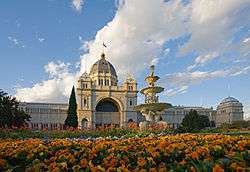 The Royal Exhibition Building, showing the fountain on the southern or Carlton Gardens side | |
| General information | |
| Location | 9 Nicholson Street, Melbourne, Victoria, Australia |
| Coordinates | 37°48′17″S 144°58′16″E / 37.804728°S 144.971225°ECoordinates: 37°48′17″S 144°58′16″E / 37.804728°S 144.971225°E |
| Construction started | 1879 |
| Completed | 1880 |
| Design and construction | |
| Architect | Joseph Reed |
| Official name | Royal Exhibition Building and Carlton Gardens |
| Type | Cultural |
| Criteria | ii |
| Designated | 2004 (28th session) |
| Reference no. | 1131 |
| State Party |
|
| Region | Asia-Pacific |
The Royal Exhibition Building is a World Heritage Site-listed building in Melbourne, Australia, completed in 1880. It is located at 9 Nicholson Street in the Carlton Gardens, flanked by Victoria, Carlton and Rathdowne Streets, at the north-eastern edge of the central business district. It was built to host the Melbourne International Exhibition in 1880–81 and later hosted (in the Western annex) the opening of the first Parliament of Australia in 1901. Throughout the 20th century smaller sections and wings of the building were subject to demolition and fire; however, the main building, known as the Great Hall, survived.
It received restoration throughout the 1990s and in 2004 became the first building in Australia to be awarded UNESCO World Heritage status, being one of the last remaining major 19th-century exhibition buildings in the world. It is the world's most complete surviving site from the International Exhibition movement 1851–1914. It sits adjacent to the Melbourne Museum and is the largest item in Museum Victoria's collection. Today, the building hosts various exhibitions and other events and is closely tied with events at the Melbourne Museum.
History

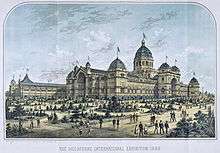
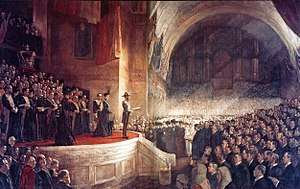
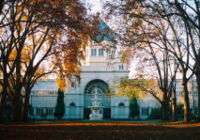
The Royal Exhibition Building was designed by the architect Joseph Reed, who also designed the Melbourne Town Hall and the State Library of Victoria. According to Reed, the eclectic design was inspired by many sources. The dome was modeled on the Florence Cathedral, while the main pavilions were influenced by the style of Rundbogenstil and several buildings from Normandy, Caen and Paris.[1]
It was built by David Mitchell, who also built Scots' Church and St Patrick's Cathedral. He was also the father of the famed soprano Dame Nellie Melba, who sang at the opening of the Provisional Parliament House in Canberra in 1927.
The foundation stone was laid by Victorian governor George Bowen on 19 February 1879[2] and it was completed in 1880, ready for the Melbourne International Exhibition. The building consisted of a Great Hall of over 12,000 square metres and many temporary annexes.
1880–1901
In the 1880s, the building hosted two major International Exhibitions: The Melbourne International Exhibition in 1880 and the Melbourne Centennial Exhibition in 1888 to celebrate a century of European settlement in Australia. The most significant event to occur in the Exhibition Building was the opening of the first Parliament of Australia on 9 May 1901, following the inauguration of the Commonwealth of Australia on 1 January. After the official opening, the Federal Parliament moved to the Victorian State Parliament House, while the Victorian Parliament moved to the Exhibition Building for the next 26 years.
On 3 September 1901, the Countess of Hopetoun, wife of the Governor-General, announced the winners of a competition to design the Australian National Flag. A large flag, 5.5 metres by 11 metres, was unfurled and flown over the dome of the Royal Exhibition Building.[3]
1901–1979
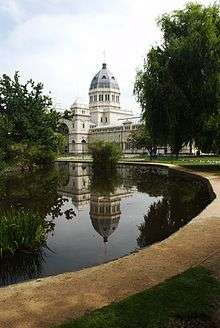
In 1902, the building hosted the Australian Federal International Exhibition.[4] The period after this time saw the building used for many purposes. It was a venue for the 1956 Summer Olympics, hosting the basketball, weightlifting, wrestling, and the fencing part of the modern pentathlon competitions.[5][6] As it decayed, it became known derogatively by locals as The White Elephant in the 1940s[7] and by the 1950s, like many buildings in Melbourne of that time it was earmarked for replacement by office blocks.[8] In 1948, members of the Melbourne City Council put this to the vote and it was narrowly decided not to demolish the building.[9] The wing of the building which once housed Melbourne Aquarium burnt down in 1953. During the 1940s and 1950s, the building remained a venue for regular weekly dances. Over some decades of this period it also held boat shows, car shows and other regular home and building industry shows. It was also used during the 1950s, 1960s and 1970s for State High School Matriculation and for the Victorian Certificate of Education examinations, among its various other purposes. The western annexe was demolished in the 1970s.[10] The last remaining original annex, the grand ballroom, was demolished amid controversy in 1979.[11] It was replaced with a new building on the same footprint providing more exhibition space, clad in mirror glass, in 1980. On 1 October 1980 during a visit to Victoria, Princess Alexandra unveiled a plaque which commemorated both the opening of the new mirror-glass 'Centennial Hall', and the centenary of the building. She also unveiled a second plaque commemorating the bestowal of the title "Royal" on the building by Her Majesty the Queen.
1980–present
Following the outcry over the ballroom demolition, and the appointment of new Trustees and a new Chair in 1983, the heritage of the building began to be seen as important as providing modern space for exhibitions.
The first conservation assessment of the building was undertaken by Alan Willingham in 1987, and over the following decades the Great hall was progressively renovated and restored[12]. In 1996, the then Premier of Victoria, Jeff Kennett, proposed the location and construction of Melbourne's State Museum in the carpark to the north, which involved the demolition of the 1960s annexes in 1997-98.
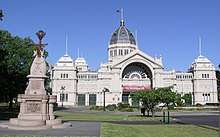
The location of the Melbourne Museum close to the Exhibition Building site was strongly opposed by the Victorian State Labor Party, the Melbourne City Council and some in the local community. Due to the community campaign opposing the museum development, John Brumby, then State opposition leader, with the support of the Melbourne City Council, proposed the nomination of the Royal Exhibition Building for world heritage listing. The world heritage nomination did not progress until the election of the Victorian State Labor Party as the new government in 1999.
On 1 July 2004, the Royal Exhibition Building and Carlton Gardens was granted listing as a World Heritage Site, the first building in Australia to be granted this status. The heritage listing states that "The Royal Exhibition Building is the only major extant nineteenth-century exhibition building in Australia. It is one of the few major nineteenth-century exhibition buildings to survive worldwide."
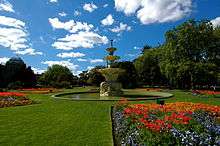
In October 2009, Museum Victoria embarked upon a major project to restore the former German Garden of the Western Forecourt. The area had been covered by asphalt in the 1950s for car parking.[13]
Current use
The Royal Exhibition Building is still in use as a commercial exhibition venue, hosting many events on a regular basis such as the Melbourne International Flower and Garden Show. Regular tours are also offered by Melbourne Museum.
The Royal Exhibition Building is used as an exam hall for the University of Melbourne, Royal Melbourne Institute of Technology, Melbourne High School, Nossal High School, Mac.Robertson Girls' High School and Suzanne Cory High School.
The building is no longer Melbourne's largest commercial exhibition centre. The modern alternative is the Melbourne Exhibition and Convention Centre, which is located in Southbank to the south of the Melbourne central business district.
References
- ↑ Wills, Elizabeth (2004). The Royal Exhibition Building, Melbourne. A Guide. Melbourne, Victoria: Museum Victoria. p. 2. ISBN 0-9577471-4-4.
- ↑ The Age Archived 21 August 2009 at the Wayback Machine.
- ↑ It's an Honour Archived 19 February 2013 at the Wayback Machine.
- ↑ "AUSTRALIAN FEDERAL INTERNATIONAL EXHIBITION". The Argus (Melbourne: 1848 - 1957). Melbourne: National Library of Australia. 1 November 1902. p. 17. Retrieved 5 November 2013.
- ↑ The Royal Exhibition Building in Melbourne
- ↑ 1956 Summer Olympics official report. p. 43.
- ↑ "The Royal Exhibition Building Archived 17 March 2012 at WebCite" museumvictoria.com.au. URL accessed on 6 November 2007.
- ↑ "Who will save Melbourne from the wrecker's ball?" theage.com.au 15 March 2004. URL accessed on 5 September 2006.
- ↑ Wills, Elizabeth (2004). The Royal Exhibition Building, Melbourne. A Guide. Melbourne, Victoria: Museum Victoria. pp. Foreword. ISBN 0-9577471-4-4.
- ↑ http://museumvictoria.com.au/reb/history/the-building/
- ↑ Museum Victoria
- ↑ "Global status for our greatest building", 21 October 2002. URL accessed on 5 September 2006.
- ↑ "World Heritage, World Futures" museumvictoria.com.au. URL accessed on 12 March 2010.
External links
| Wikimedia Commons has media related to Royal Exhibition Building. |
- World heritage listing for the Royal Exhibition Building
- Royal Exhibition Building at Museum Victoria
- Images of Royal Exhibition Building



